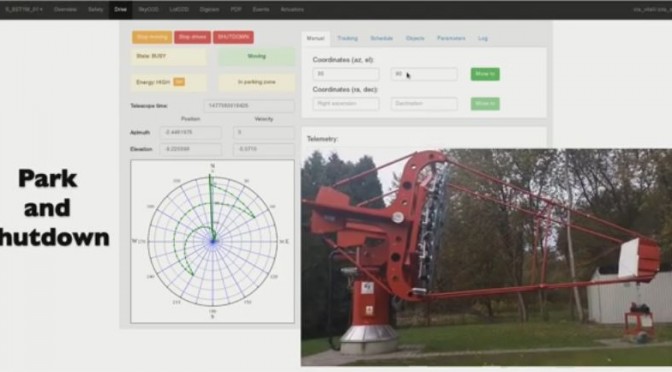Oprogramowanie sterujące teleskopem i kamerą zostało w ostatnich dniach pomyślnie przetestowane. Prototyp konstruowanego przez nas teleskopu SST-1M zlokalizowany jest w Krakowie, w Instytucie Fizyki Jądrowej przy ul. E. Radzikowskiego, niecałe 4 km w linii prostej od budynku C‑3 AGH. Sterowanie odbywało się z INTEGRAL Science Data Center Wydziału Astronomii Uniwersytetu w Genewie. Ten film przedstawia działanie teleskopu SST-1M podczas jednego z testów.
Pełny tekst komunikatu w biuletynie CTA:
SST-1M Prototype Prepares for First Light
The Single-Mirror Small-Size Telescope (SST-1M) team has made significant progress recently with the telescope/camera control and the complete integration of the camera with the prototype structure. The advances bring the team much closer to their ultimate goal: the telescope’s first observation of Cherenkov light.
The telescope and camera control software was successfully tested in two end-to-end tests, controlling the SST-1M telescope prototype (located in Krakow) and its camera, the DigiCam, (located in Geneva) from the INTEGRAL Science Data Centre, Department of Astronomy in Geneva. The attached video shows the SST-1M in action during one of the tests.
All sub-systems of the telescope have been interfaced with the official CTA framework (the ACS — ALMA Common Software). The software for the drive system responsible for moving the telescope and the charge-couple device (CCD) cameras responsible for aligning mirror facets and pointing to sources is almost complete. The master control process to coordinate all software components and to provide the high-level interface with the common software to all CTA telescopes is under development, as well.
The SST-1M’s camera, DigiCam, was assembled this fall and has been undergoing testing at the Département de Physique Nucleaire et Corpusculaire (DPNC) at the University of Geneva. This innovative camera uses 1,296 silicon photomultipliers (SiPMs), acquiring data on photons hitting the pixels of the camera at a huge rate. The total data stream of DigiCam is 6.6 Tb/s, so it can efficiently capture a snapshot of the sky 10,000 times per second.
The fully digital readout and trigger electronics, designed by the Jagiellonian University and AGH University of Science and Technology, have been integrated into the camera and cooling and vibration tests are complete. After more testing in December, it will be installed on the roof the Geneva observatory to test its ability to detect Cherenkov light from cosmic rays. The camera will be integrated with the prototype telescope structure in Krakow to test the complete assembly and to prepare the SST-1M prototype for gamma-ray light detection.

